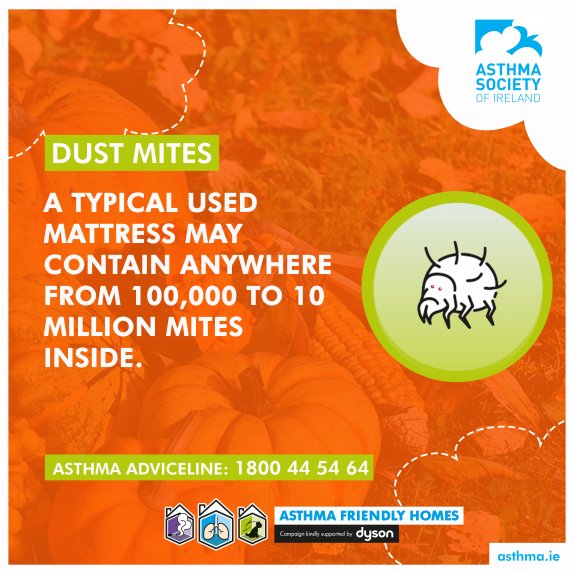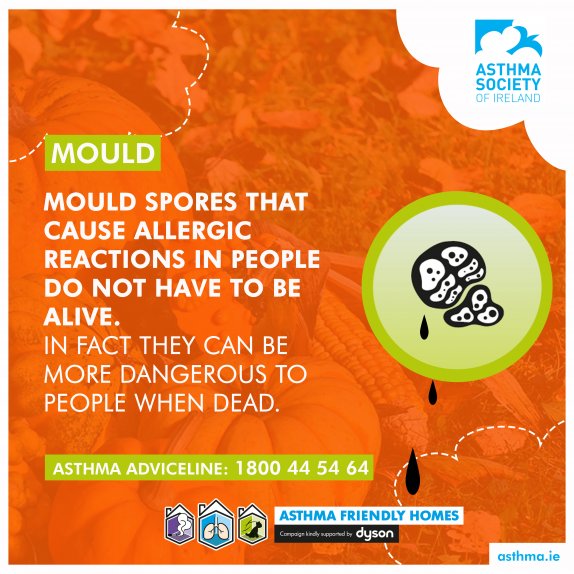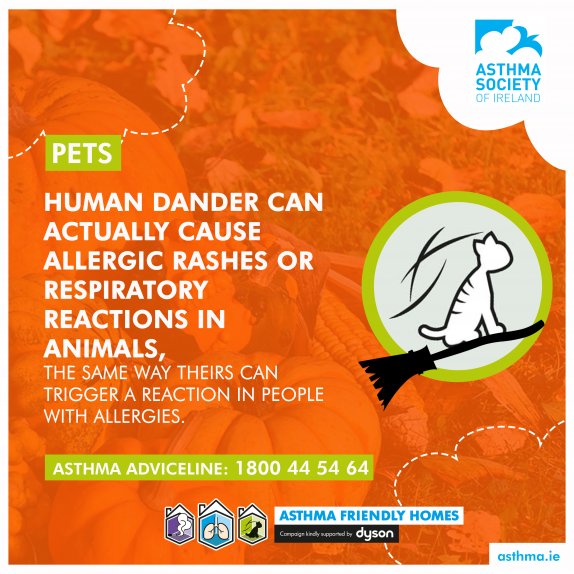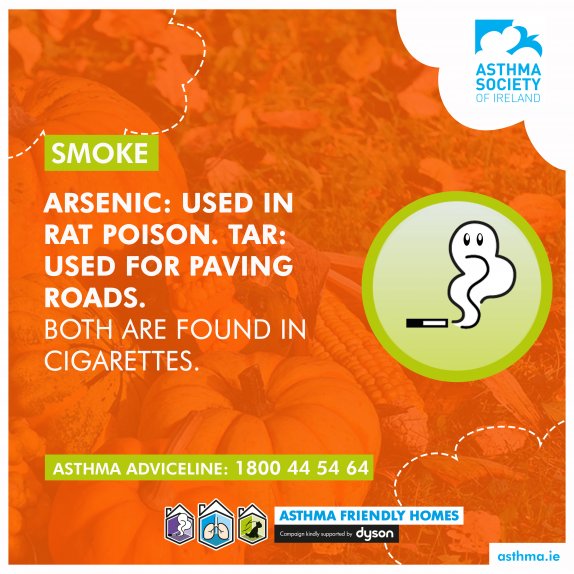
With Halloween just around the corner, the Asthma Society is highlighting four asthma triggers that will keep everyone awake at night.
Sarah O’Connor, CEO of the Asthma Society, said: “The symptoms of asthma can be extremely frightening for people with asthma so it makes sense that the things that trigger these symptoms are pretty scary for people too. We’re encouraging people to take their asthma triggers seriously this Halloween so they can stay well through the winter. We’ve put together a list of some of the most terrifying triggers and some top tips to help you banish these triggers from your home.”
“Dreadful” Dust mites:
House dust mites are tiny, spider-like creatures that live in fabrics, carpets and soft furnishing. They’re found in every home, school or office, no matter how clean. House dust mites like to live in places like your bed, your sofa and your curtains but because they’re invisible to the naked eye, you won’t be able to see them. What do dust mites eat? You! Dust mites feed off the dead human skin cells which make up about 70% of dust in the home. Some people with asthma may find their symptoms get worse when dusting or vacuuming, this is often because these activities bring settled dust into the air where it can be inhaled. Most people who have asthma symptoms that are triggered by house dust mites are actually reacting to their faeces!
While it is impossible to completely get rid of house dust mites there are plenty of steps you can take to reduce them and limit their impact on your asthma.

- Damp-dust your house at least once a week
- Remove any unwanted clutter in your home to avoid gathering dust
- Wash your sheets, pillow cases, blankets and cuddly toys at 60 degrees or hotter every week
- Use allergy-proof covers for mattress, pillow and blankets
- Vacuum your pillows and mattress
- Wear a dust mask when dusting
- Some people find air purifiers are helpful in reducing symptoms
“Manky” Moulds:
Moulds come in many shapes, colours and sizes. They can be powdery, slimy or even fluffy! Moulds grow best in damp places like bathrooms, kitchens, woody areas and even piles of autumn leaves. Sometimes, moulds may grow in corners or behind furniture, so you might notice until your home has already been invaded! Keeping your home dry and well ventilated is the best way to defend against these sneaky trespassers. If moulds are a trigger for your asthma, you may be allergic to the tiny, air-borne spores that moulds use to spread and grow.
There are plenty of things you can do to tackle mould in your home.

- Avoid drying clothes indoors. As they dry more moisture is released into the air in your home, which may allow mould to grow
- When showering or cooking, use your extractor fan or open a window to let out the steam
- Moulds will only grow in moist conditions:
- Check for any leaks around your pipes or water appliances
- Use a dehumidifier to reduce the moisture content if necessary
- Wear a scarf over your mouth when the weather is wet and windy to avoid breathing in the spores which are carried in the air during thunderstorms
- During autumn, keep away from clusters of fallen leaves which are a perfect breeding ground for mould.
“Putrid” Pets:
61% of households own a family pet. However, many people are allergic to proteins that are present in the hair, feathers, saliva and dead skin cells shed by their animals. Although pets are a part of the family, they can present a huge problem for some people with asthma. Animals such as cats, dogs and horses are among the biggest culprits but even animals like snakes and birds can trigger asthma symptoms for some people.
If your pet is a trigger for your asthma, it should be rehomed if possible. If this is not possible it can be difficult to limit the impact on your asthma but there are steps you can take.

- Keep pets away from living areas and the bedroom, especially from fabric covered furniture, rugs and carpets
- Keep your pet outside as much as possible
- Ensure your pet is properly washed by someone else
- Vacuum regularly using a vacuum suitable for pet hair
- If your pet is in a cage, make sure the cage is properly cleaned as often as possible
“Sickening” Smoke:
Everyone knows that smoke is extremely bad for us, but between bonfires, fireworks and open fires, it can be hard to escape at this time of year. There over 7,000 chemicals in tobacco smoke alone and cigarettes release more than a billion harmful “free radicals” per puff. This isn’t good for anyone but particularly for people with asthma. When someone with asthma inhales tobacco smoke either from smoking or from second hand fumes, irritating substances settle in the moist lining of the airways within the lungs. This causes inflammation in the lungs which can bring on asthma symptoms and even cause an asthma attack.
If you have asthma:

- It’s important to avoid smoking completely
- Do not allow others to smoke in your home
- Keep your distance from others smoking in public
- Keep your reliever inhaler with you at all times, especially if you’re going to a bonfire or fires works display and ensure the people around you are aware of your condition
For more information or advice on potential triggers within your home, you can call the Asthma Society’s free adviceline on 1800 44 54 64.
The Asthma Society has teamed up with Dyson and is launching its Asthma Friendly Homes campaign to make people aware of common triggers in the home and what you can do to combat them. A new Asthma Friendly Homes leaflet is now available. We urge everyone with asthma to download the leaflet and make those triggers disappear!



